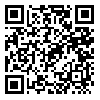Volume 34, Issue 1 (3-2025)
JGUMS 2025, 34(1): 42-55 |
Back to browse issues page
Research code: 1258
Ethics code: IR.GUMS.REC.1397.508
Download citation:
BibTeX | RIS | EndNote | Medlars | ProCite | Reference Manager | RefWorks
Send citation to:



BibTeX | RIS | EndNote | Medlars | ProCite | Reference Manager | RefWorks
Send citation to:
Zia Ziabari S M, Motamed B, Bakhshayesh Eghbali B, Noori Roodsari N, Kamiar Y, Asgari Gesht Rudkhani A et al . Insulin Therapy to Control Hyperglycemia in Diabetic Patients With Ischemic Stroke: A Comparative of Intravenous and Subcutaneous Injection. JGUMS 2025; 34 (1) :42-55
URL: http://journal.gums.ac.ir/article-1-2712-en.html
URL: http://journal.gums.ac.ir/article-1-2712-en.html
Seyyed Mahdi Zia Ziabari1 

 , Behrang Motamed2
, Behrang Motamed2 

 , Babak Bakhshayesh Eghbali3
, Babak Bakhshayesh Eghbali3 

 , Nazanin Noori Roodsari *1
, Nazanin Noori Roodsari *1 

 , Yasman Kamiar1
, Yasman Kamiar1 
 , Ashkan Asgari Gesht Rudkhani3
, Ashkan Asgari Gesht Rudkhani3 

 , Mohammad Ali Yazdanipour3
, Mohammad Ali Yazdanipour3 




 , Behrang Motamed2
, Behrang Motamed2 

 , Babak Bakhshayesh Eghbali3
, Babak Bakhshayesh Eghbali3 

 , Nazanin Noori Roodsari *1
, Nazanin Noori Roodsari *1 

 , Yasman Kamiar1
, Yasman Kamiar1 
 , Ashkan Asgari Gesht Rudkhani3
, Ashkan Asgari Gesht Rudkhani3 

 , Mohammad Ali Yazdanipour3
, Mohammad Ali Yazdanipour3 


1- Department of Emergency Medicine, Faculty of Medicine, Poursina Hospital, Guilan University of Medical Sciences, Rasht, Iran.
2- Department of Internal Medicine, Faculty of Medicine, Razi Hospital, Guilan University of Medical Sciences, Rasht, Iran.
3- Neuroscience Research Center, Trauma Research Institute, Guilan University of Medical Sciences, Rasht, Iran.
2- Department of Internal Medicine, Faculty of Medicine, Razi Hospital, Guilan University of Medical Sciences, Rasht, Iran.
3- Neuroscience Research Center, Trauma Research Institute, Guilan University of Medical Sciences, Rasht, Iran.
Abstract: (1091 Views)
Background The stress hyperglycemia is different from diabetes and is common after an acute illness such as stroke.
Objective This study aimed to compare the effect of intravenous (IV) and subcutaneous (SQ) insulin injections on controlling hyperglycemia in diabetic patients with acute ischemic stroke (AIS).
Methods This cross-sectional analytical study was conducted on 242 diabetic patients with AIS referred to the Emergency Department of Poursina Hospital in Rasht, Iran. During the treatment, the patients were subjected to SQ or IV insulin protocols. In each group, patients’ blood glucose and potassium levels in the first 24 hours, along with other variables, were recorded and compared between the two groups using independent t-test, chi-square test, or repeated measures analysis of variance.
Results The mean blood glucose levels in the SQ insulin group at the time of admission and 6 and 12 hours after admission were significantly lower than in the IV insulin group. The blood sugar reduction, especially 6 hours after admission, was considerably higher in the IV insulin group. The incidence of hypokalemia in the IV insulin group was significantly higher than in the SQ insulin group. In almost all cases, IV insulin administration resulted in a faster and more effective reduction in blood sugar levels within 6 hours after admission compared to the SQ administration. Also, patients with higher initial blood levels responded significantly better to IV insulin protocol in reducing blood sugar levels.
Conclusion The IV insulin protocol is more effective than the SQ insulin protocol in controlling or reducing hyperglycemia in diabetic patients with AIS in the first hours of admission and does not cause serious complications.
Objective This study aimed to compare the effect of intravenous (IV) and subcutaneous (SQ) insulin injections on controlling hyperglycemia in diabetic patients with acute ischemic stroke (AIS).
Methods This cross-sectional analytical study was conducted on 242 diabetic patients with AIS referred to the Emergency Department of Poursina Hospital in Rasht, Iran. During the treatment, the patients were subjected to SQ or IV insulin protocols. In each group, patients’ blood glucose and potassium levels in the first 24 hours, along with other variables, were recorded and compared between the two groups using independent t-test, chi-square test, or repeated measures analysis of variance.
Results The mean blood glucose levels in the SQ insulin group at the time of admission and 6 and 12 hours after admission were significantly lower than in the IV insulin group. The blood sugar reduction, especially 6 hours after admission, was considerably higher in the IV insulin group. The incidence of hypokalemia in the IV insulin group was significantly higher than in the SQ insulin group. In almost all cases, IV insulin administration resulted in a faster and more effective reduction in blood sugar levels within 6 hours after admission compared to the SQ administration. Also, patients with higher initial blood levels responded significantly better to IV insulin protocol in reducing blood sugar levels.
Conclusion The IV insulin protocol is more effective than the SQ insulin protocol in controlling or reducing hyperglycemia in diabetic patients with AIS in the first hours of admission and does not cause serious complications.
Review Paper: Research |
Subject:
Special
Received: 2024/06/2 | Accepted: 2024/10/7 | Published: 2025/04/1
Received: 2024/06/2 | Accepted: 2024/10/7 | Published: 2025/04/1
| Rights and permissions | |
 |
This work is licensed under a Creative Commons Attribution-NonCommercial 4.0 International License. |






